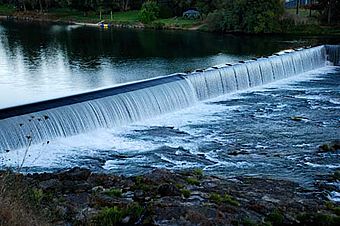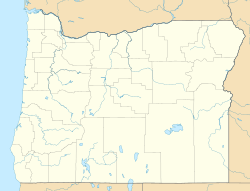Winchester Dam facts for kids
Quick facts for kids |
|
|
Winchester Dam
|
|

The dam in 2010
|
|
| Location | N. Umpqua River at Hwy. 99, Winchester, Oregon |
|---|---|
| Area | 2.2 acres (0.89 ha) |
| Built | 1890 |
| Architect | Briggs, Charles |
| NRHP reference No. | 96000627 |
| Added to NRHP | June 3, 1996 |
The Winchester Dam is a structure built on the North Umpqua River in Winchester, Oregon. It was constructed in 1890 and later added to the National Register of Historic Places in 1996.
This dam was originally made from large wooden frames called timber cribs. When it was first built, the dam was only about four feet (1.2 meters) tall. In 1907, it was made taller, reaching sixteen feet (4.9 meters). For many years, until 1923, the dam provided water and electricity to the nearby town of Roseburg. Today, the parts that made electricity are gone. The dam is now kept up for fun activities like boating and fishing by the people who live around the reservoir.
Contents
Why is Dam Safety Important?
The Winchester Dam is considered a "high hazard" dam by the Oregon Department of Water Resources. This means that if the dam were to break, it could cause serious harm or even loss of life to people nearby. Many people use the river, parks, and boat ramps located just downstream from the dam.
In October 2019, after a yearly check, state officials said the dam was in "poor" condition. They asked the owners to hire an engineer to check the dam's structure very carefully. They also warned the owners to fix any known safety problems soon. The dam had not received a full structural check since 1987. Also, its emergency plan, which tells people what to do if the dam fails, had not been updated since 1987.
How Does the Dam Affect Drinking Water?
In January 2020, the Oregon Department of Environmental Quality (DEQ) gave a fine to the dam owners. This was because of problems during a repair job at the dam in late 2018. The DEQ said that pollution from this repair hurt the homes of water animals. It also killed many fish.
Even worse, the pollution harmed the main source of drinking water for the City of Roseburg and the Umpqua Basin Water Association. Together, these groups provide water to about 37,700 people. Officials found that the dam repairs were done without following important rules to protect water quality and fish. This happened even though state and federal groups had given advice on how to do the repairs safely.
How Does the Dam Affect Fish?
The Winchester Dam has been a concern for fish, especially salmon, for many years. In 1994, a group called Oregon Natural Resources Council said that several dams in the Pacific Northwest, including Winchester Dam, should be removed. They believed these dams were harming salmon and other fish. Since then, some of those dams have been taken down. However, the Winchester Dam is still standing.
Fish Passage Challenges
In 2013, the Oregon Department of Fish and Wildlife (ODFW) put Winchester Dam on a special list. This list names the top man-made barriers that stop native fish from migrating. By 2019, Winchester Dam was ranked as the second-highest privately owned dam on this list. It blocks fish from reaching 160 miles (257 kilometers) of good habitat. This habitat is important for many types of fish, including:
- Spring Chinook salmon
- Fall Chinook salmon
- Summer steelhead trout
- Winter steelhead trout
- Cutthroat trout
- Pacific Lamprey
It also affects Southern Oregon Coast Coho salmon, which are listed as threatened under the Endangered Species Act. This means they are at risk of disappearing.
The ODFW staff work on the fish ladder at Winchester Dam. A fish ladder helps fish swim past a dam. However, the ladder at Winchester has some problems. It has sharp turns, and it's hard to control the water flow inside it. This makes it difficult for fish to use the ladder effectively at different water levels in the river. In 2019, several conservation and fishing groups offered to pay for an expert to study the ladder and find ways to make it better. But the dam owners did not agree to this offer.
Fish Counting Station
Even though the fish ladder at Winchester Dam does not meet modern standards for helping fish pass, it has been useful for gathering information. Since 1945, there has been a fish counting station here. The Oregon Department of Fish and Wildlife maintains this station.
At the station, scientists count fish to learn about their populations. This information helps them decide how to manage fish and set rules for fishing. Since 2015, less money has been available for counting fish at the station. Because of this, some local fishermen have wondered if the counting results are still accurate.
Images for kids




